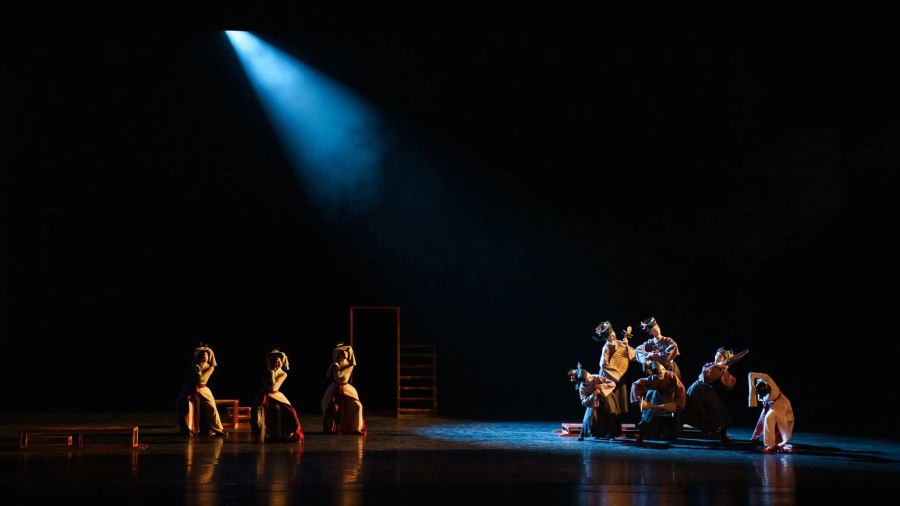

Inspired by the eponymous mural in the tomb of Zhang Shiqing, the dance drama “Diverse Ensemble” represents a profound exploration of the artistic legacy of the Liao Dynasty. The tomb mural depicts a captivating “san yue” performance, a unique blend of music and dance that diverges from the more familiar styles of the Han and Tang Dynasties. It's bold colors and dynamic forms embody the distinctive essence of northern ethnic minorities, offering a stark contrast to the aesthetics of the Central Plains. This divergence was precisely what motivated me to create this piece.

Photo of the dance performance "Diverse Ensemble". (Photo provided to Guangming Online)
The challenge of breathing life into historical artifacts and imbuing them with a profound sense of historical and cultural weight was central to the creative process. To overcome such challenges, we dedicated significant effort to unearthing the historical context of the artifacts to establish an aesthetic image and body language in line with the style of that era.
Rooted in the history of Liaoning in the Khitan-Liao era, the “Diverse Ensemble” mural is a captivating fusion of the artistic elements from the Tang, Five Dynasties, and Later Jin dynasty. It embodies the inclusivity of northern multi-ethnic cultures while showcasing the rugged and archaic characteristics of the Khitan people. To better understand the regional attributes and aesthetic traits of the era, our team conducted extensive field research at the Liaoning Museum in June 2021 and the Xiaotaihou (literally “Empress Xiao”) River Exhibition Hall in Beijing in August 2022. Given the historical context of ethnic conflicts, book bans, and the nomadic lifestyle of the Khitan people, it is exceedingly rare to find surviving Liao artifacts, let alone those depicting musical or dance performances. The original mural, with the distinctive “forehead-sleeve posture,” offers a mere glimpse into the original dancing style. Naturally, this precious “seed image” became the foundation upon which we choreographed the various segments of the dance.

Photo of the dance performance "Diverse Ensemble". (Photo provided to Guangming Online)
Professor Chen Bingyi’s monograph, “A Study of Ancient Khitan-Liao Musical Culture in China,” proved invaluable. It provided profound insights into the history of Khitan-Liao music, the instruments used, their performance settings, and playing techniques. The original mural features five musicians playing distinct instruments: the bili and sheng (wind instruments), the waist drum and clapper (percussion instruments), and the pipa (a plucked string instrument). Each instrument had its own rules and visual posture. Beyond choreographing the dancers’ movements, we meticulously crafted clear and unique performing identities for each musician, integrating them seamlessly into the dance, which resulted in intricate layers of interaction: dialogues between musicians, singers responding to players, musicians directing dancers, and dancers weaving together their movements – all these layers jointly form a captivating interplay of harmony and dynamic energy.
Despite the scarcity of historical records and artifacts, our field studies and research allowed us to immerse in Liao’s unique aesthetics. Such aesthetics, in stark contrast to that of ancient Central Plains, exude rawness, resilience, and bravery. Consequently, the performance unfolds in a seamless fusion of music and dance, rich with scenes of singing and movement, and the physical presentation becomes one that reflects weightiness, rustic charm, and strength. With an unwavering dedication, we managed to inject into the creative process a steadfast and resolute spirit, as well as strong personal convictions.
Above all, I adhered to the approach inspired by my mentor, Professor Sun Ying, who emphasizes decoding and revitalizing historical artifacts. The creative process hence was a means to awaken the cultural codes of antiquity. Through “Diverse Ensemble,” I wish to inspire a deeper understanding of the Liao culture, breathing new life into this historical period and bringing onto modern stage its invaluable cultural legacy.
Contributed by Tian Tian, Director and Choreographer of “Diverse Ensemble”
点击右上角![]() 微信好友
微信好友
 朋友圈
朋友圈

请使用浏览器分享功能进行分享
